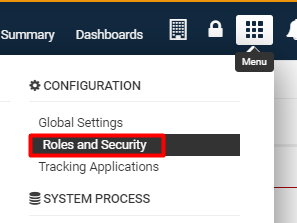Difference between revisions of "Roles and Security Settings"
(→Access) |
(→Access) |
||
| Line 34: | Line 34: | ||
'''[[Visibility Permissions#System Visibility Permissions|System Visibility Permissions]] - '''Allows for System Administrators to personalize their copy of SmartSimple, making various system objects available to users in different roles. In the '''Visibility '''permissions, you can '''limit ''''''View Access '''and''' hide '''certain features. | '''[[Visibility Permissions#System Visibility Permissions|System Visibility Permissions]] - '''Allows for System Administrators to personalize their copy of SmartSimple, making various system objects available to users in different roles. In the '''Visibility '''permissions, you can '''limit ''''''View Access '''and''' hide '''certain features. | ||
| − | '''Legacy Application Permissions - ''' | + | '''[[System Feature Permissions#Legacy Application Permission|Legacy Application Permissions]] - ''' |
|- | |- | ||
Revision as of 13:41, 21 June 2019
Overview
The Roles and Security Settings of your SmartSimple instance can be accessed through the following steps:
1. Click the 9-square menu icon on the top right of your page.
2. Under the heading Configuration, select Roles and Security Settings.
The Roles and Security Settings page will be displayed.
Access
This page allows access to the following configuration pages within SmartSimple:
| Roles and Categories |
User Roles - Use roles in order to control the menu, portal, reports, and fields associated with a specific group of users or contacts. Roles also control field visibility and the types of contacts that a user in a specific role is able to add into the system. It is under this tab that you are also able to edit the Common Portal, the aggregated portal that can be helpfully applied to users in all roles rather than a specific role.
|
| System Security Settings |
Security Settings - Manage business and system security settings, including Password Policy and Email & Email Broadcast Security. Arcadia Permissions - Determine which roles are associated with the Arcadia Interface, and if necessary, permission some roles to be able to switch to the Classic Interface (now deprecated as of November 2018 upgrade). System Feature Permissions - Allows for System Administrators to personalize their copy of SmartSimple, making various system objects available to users in different roles. The Feature permissions will allow you to modify the accessibility of certain system features, such as Notes, Reports, SmartFolders, and more. 'System Visibility Permissions - Allows for System Administrators to personalize their copy of SmartSimple, making various system objects available to users in different roles. In the Visibility permissions, you can limit 'View Access and hide certain features. |
| -based Settings |
UTA Security Settings - UTA Visibility Settings - |
- System Feature Permissions - Allows for system administrators to personalize their copy of SmartSimple and to make various system objects available to users in different roles.
- System Visibility Permissions - Allows for system administrators to personalize their copy of SmartSimple and to make various system objects available to users in different roles.
- Legacy Application Permissions - Determine which roles are associated with base application functions.
- UTA Settings
- UTA Security Permissions - Security settings of the UTA.
- UTA Visibility Permissions - Determine visibility permission for various objects and control

